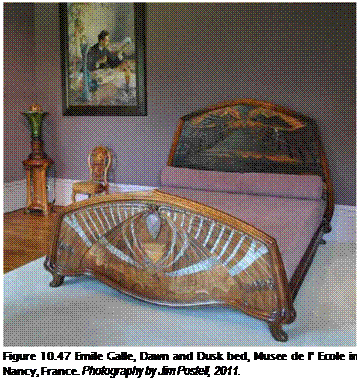According to Herman Muthesius, "arts and crafts were called upon to restore our awareness of the honesty, integrity, and simplicity in contemporary society. If this can be achieved, the whole of our cultural life will be profoundly affected. . . . If the new trends are genuine, then an original, lasting style will emerge."8 Trend-setting furniture became popular at the end of the nineteenth century, inspired by designers, fine artists, architects, writers, and other professionals. It was this collection of tastemakers that spawned new movements of design that came to be known as Arts and Crafts, including the Gothic Revival, the Glasgow School, Art Nouveau, and the Vienna Secession. The authentic craftsmanship of furniture designed by the Scottish architect Charles Mackintosh, by English architect C. F. A. Voysey, and other prominent designers became popular at the beginning of the twentieth century.
Fmile Galle (1846-1904) worked with stained glass and designed furniture in Nancy, France. His works, along with those of the Fcole de Nancy, founded in 1890, are traditionally cited as the origin of the French Arts and Crafts movement (Figure 10.47). The Fcole de Nancy was a cooperative group organized for the production of the decorative arts. The cooperative idea was an attempt to make a complete design statement and create a unified look for everything from furniture to clothes, graphics, and architecture. It was here that elegant lines referencing flora and fauna found their way into tables, chairs, desks, windows, and doors. The French Arts and Crafts movement continued to evolve into the French Art Nouveau, while the work of Charles Robert Ashbee (1863-1942) of England had a simpler and somewhat machined aesthetic.
British-born designer and architect Charles Rennie Mackintosh (1868-1928) of Glasgow, Scotland, opened the door to a new spirit of modernism. Mackintosh created furniture and interior spaces whose design were rooted in the tradition of Pugin and Morris. His approach in designing furniture was similar to his approach in designing an interior of a bedroom or the exterior of a building. He labored intensely in drawing, water coloring, and treated the documentation and presentation of each project as a work of art. Mackintosh was ultimately concerned with the final appearance of his work, more than he was in the selection of materials, craftsmanship, or in its fabrication. Many of his most famous furniture designs were fabricated for his architectural commissions, including the Glasgow School of Art (1897), the
 |
 |
Glasgow Tea Rooms (Figure 10.48) for Miss Cranston (1897), and Hill House (1902-1904) located in Helensburgh, Scotland. Remarkably, Mackintosh designed over 400 pieces of furniture in a working career of only 25 years, with little repetition of any one design.


